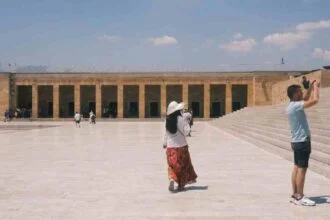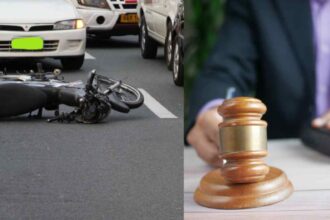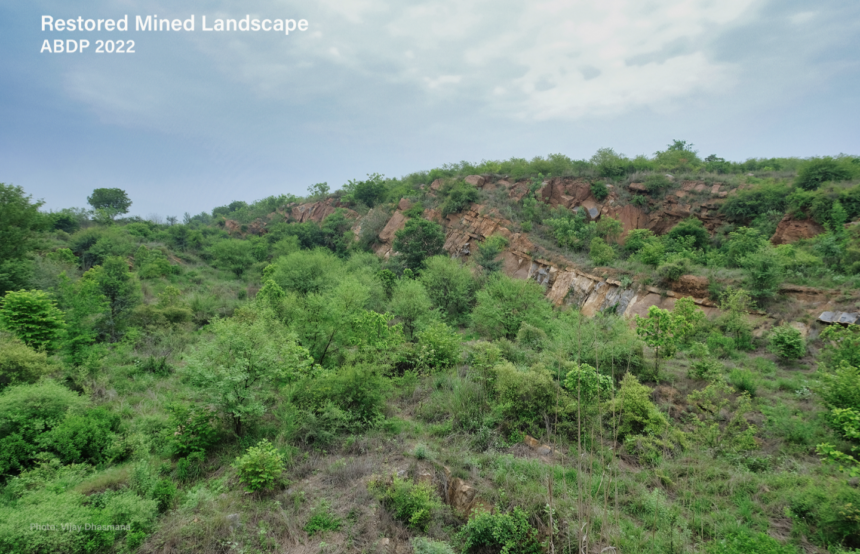Introducing Vijay Dhasmana The Man Responsible For Restoring Forests In Degraded Landscapes Of India
Deforestation in India is the widespread destruction of major forests caused by clearing of forests over vast areas for development, colonization of forest lands for agriculture, the practice of shifting cultivation, overgrazing by pastoral groups, extraction of timber for fuel, mining and mineral processing are the factors that have led to land degradation in India.
This vicious circle directly affects the livelihood of people dependent on forests.
Forests’ decrease will lead to an increase in the levels of carbon dioxide in the air. The temperature will be boosted upon the earth’s surface. The food and shelter of animals will be absent. A decrease in forest will lead to natural calamities like floods. Major climate change: Increase in temperature and pollution level.
It is extremely crucial now to regain our forest covers and save what is left of our environment.
The Story Of Vijay Dhasmana
Vijay Dhasmana is one such citizen of Urban India, who felt the need to take action on a personal level to regain our Forest covers.
He has been working towards restoring degraded landscapes in the states of Haryana, Rajasthan and Uttarakhand since 2007.
Vijay is a Member of State Biodiversity Council, Delhi; Expert Member of Supreme Court Oversight Committee for the Development of Delhi-Dehradun Road; Member of Rajasthan State Biodiversity Board Committee on Heritage Trees.
He is presently engaged in several projects, some of which have got national recognition, such as restoring the 380-acre mined site in Gurugram called Aravalli Biodiversity Park.
Also read: H1B fees hiked massively
Today, the Aravalli Biodiversity Park showcases more than 300 species of plants, many of them being reintroductions to the Haryana Aravallis.
This transformation journey started in 2010, when Vijay was reached out by a citizens initiative “iamgurgaon” to plant native trees. They wanted to plant ‘a million trees’ and create a nature park on an old mining site at the edge of Gurgaon towards Delhi.
It was a huge 380-acre site, which was completely degraded and left in a sad condition. Vijay was heartbroken to see the devastated land that was a former mining site for quartzite rock and its orange, gravelly degrade, known as ‘badarpur’ and a stone crushing zone. It was barren and had hardly any vegetative cover except for some straggling, invasive Vilaiti Keekar (Prosopis juliflora). Mining was banned for several years and what was left was truly ugly and barren with no grass cover or vegetation.
Usually such wastelands are encroached upon and turned into slums or misused for random commercial activity or turned into dumping grounds. IamGurgaon (IAG), a voluntary group recognised the need to preserve this large, empty wasteland on the fringes of Gurgaon from encroachment. In 2009 they proposed that it should be developed into a park and this proposal was taken up seriously by the Municipal Commissioner. Once Vijay joined them, together they envisioned to recreate a native Aravalli rocky forest scape with its full panoply of plants, shrubs and the full range of ephemeral grasses that spring up during the rains.
Government organizations and Forest dept people often get involved with such environmental projects and randomly start planting trees assuming they are saving the environment . But they do not check with experts and all their efforts go to waste. They plant exotic trees or saplings collected from other regions which are not suitable for the rocky Aravalli location. The result is – No result at all, all efforts are wasted and lakhs of taxpayers money goes down the drain.
Any activity when started with a large team, takes time to create the right template. Within IAG, after lots of deliberations, everybody in the team slowly began to change their attitude and see that it wasn’t about planting a million trees but creating a landscape and a habitat that was in harmony with the plants that grew in it. Agreeing to a common vision of recreating Aravaliforestscape was crossing the first stage. It took many visits to Mangar Bani, Sariska and other lovely forests of Aravallis to create a vision to transform a native Aravalli rocky forest scape with its full panoply of plants—trees like Dhau (Anogeissus pendula), Kummath (Senegalia senegal), Salai (Boswellia serrata), Doodhi (Wrightia tinctoria) and Dhak (Butea monosperma) etc.
Actual visits were organized to invite various government officials, up to the new Municipal Commissioner, Sudhir Rajpal, to Mangar Bani so he could see what they meant when they talked of native wilderness, and changed their perspective positively.
This was a game changer when MCG ratified the goal of making the Biodiversity Park into a City Forest. IAG was formally assigned the tasks of carrying out conservation work, setting up a nursery of native plants, and doing the necessary research and surveying. They were given eight years—from 2012 to 2020—to implement these tasks.
During the initial stage, they came up with an initial list of about 200 forest species native to the rocky northern Aravallis. Some of them appeared to be extinct but there was enough evidence to know they did exist. Next stage was to collect the seeds of all these species and take complete charge of rewilding the park landscape. When the next fruiting season came around, they mounted a massive collection drive for seeds and vegetative cuttings by visiting wild and semi-wild areas near and far.
Vijay’s special task was to try and understand where each kind of plant would be most ‘at home’. There is tremendous back end work that goes on while planning such a massive drive.
Vijay says,” Even a place like the Biodiversity Park is made up of a mosaic of tiny micro-habitats. Some plants are ‘generalists’, but most plants—more so in arid or stressed environments—specialize in where they are best adapted to live and do well, in different kinds of sites such as the foot of a hill or a hollow where there is sandy soil, or on a well-drained slope.”
Vijay Dhasmana spent a lot of time learning about seeds and collecting them, about plant conditions, and enlightened him knowledge about how Dhau(Anogeissus pendula) grew on steep rocky slopes, Salai (Boswellia serrata) on the shoulders of hills, Babool (Acacia nilotica) only where the soil is deep and of good quality, with water close to the surface. The idea was not to make this park into a dense woodland but to create diverse habitats, including grasslands that would support varied forms of life typical of northern Aravalli.
Dealing with nature takes a lot of patience and perseverance. Results are not seen immediately but if we hold onto our vision, results will surely be positive.
The nursery work was expanding fast. IAG team started involving citizens, children and Gurgaon’s corporates in support of the Park. All their funds came through donations. After all the intensive efforts taken, the Aravalli Biodiversity Park showcases more than 300 species of plants. Many of the saplings were reintroduced to Haryana which otherwise had become extinct. The park has diverse microhabitats and this has helped to attract 206 species of birds, making it one of the richest birding habitats in Delhi’s NCR. Animals such as Nilgais, jackals, palm civets, porcupines, hares, snakes and lizards are thriving in the Biodiversity Park today.
Vijay and the IAG team initiated many nature walks in the Gurgaon city which created huge awareness, especially amongst the youth. Corporates usually have to conduct CSR activities and encourage their staff to get involved with social causes. Many started volunteering to clean up composting leaf litter, garbage or other team building activities that were conducted in this park. In the past seven years, fifty-eight corporations, more than fifty schools, thousands of children, and locals from all sectors have come to plant about 145,000 plants of 200 species in the Biodiversity Park.
Land is a huge revenue generating opportunity and there are always people who propose to turn this biodiversity park into a money spinning public park, a zoo, a crocodile park or night safari tourist place. Some even suggested cutting through the park to make a highway. There is hope to preserve this park because of all the support they receive from the people of Gurgaon.
“Start by doing what’s necessary; then do what’s possible; and suddenly you are doing the impossible.” – Francis of Assisi.
Hard work, dedication, belief and faith in your vision and support from genuine aware citizens led to positive results.
In 2022, Aravalli Biodiversity Park was declared as India’s first Other Effective Area-based Conservation Measures (OECM) site by the IUCN, notifying it as a non-protected area that supports a rich biodiversity. Hero MotoCorp Ltd., through its CSR, has taken up the second phase of development and management of the park since 2021 and added some interesting features to improve the experience like viewing deck etc.
A mine is a place where deep holes and tunnels are dug under the ground in order to obtain important minerals such as rocks, coal, gold or diamonds etc. Once the project is over, the team moves to a new location, leaving the landmines behind, uncared for, barren.
The landmines near Gurgaon were part of this neglect and open for encroachment. It was all because of the efforts of Vijay and members of IAG team that this land mine region has now been transformed into a native Aravalli forest which the future generations can enjoy.
The struggle is not over. A lot has yet to be done and Vijay has now got into this mission with all his might. The Aravalli Biodiversity Park still has a way to go before it becomes a mature forested landscape. This initiative has set examples for others to follow. This is the only eco-restoration project in India where citizens, corporations and the local administration have collaborated to bring a natural forest landscape back to a city.
Vijay Dhasmania did not stop after creating one forest. He started his next project in another site opposite of the Park and recreating Aravali forests.
His future plans are to restore as much degraded lands in the country as possible, recreating grasslands, shrublands and savannahs.
Vijay realizes that youth are the future of tomorrow. His message for the coming generations is to start local, get involved and see the transformation in your surroundings. Things will change and there is hope if we put our mind to it.
Contact details
Email: vijay.dhasmana@gmail.com
Website: therewilders.in
TELL US YOUR STORY AT: connect@nomadlawyer.org
What is SalamatRaho
Team NomadLawyer’s ambition is to positively impact the world through the stories of HumanKind. We believe in the art of storytelling. Through “Salamat Raho ”, we are creating a database for social good in the form of “Impact Stories”, which will help us achieve our goal and reach out to the world at large. By contributing through your stories and experience you create a significant impact on the community and an exceptional experience for yourself. Visit the NomadLawyer portal at nomadlawyer.org and you can also get in touch with us at connect@nomadlawyer.org
We will use hashtag #SalamatRaho for the series.






